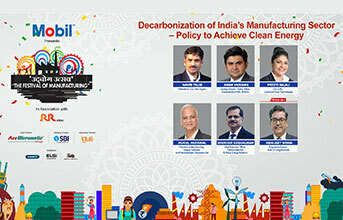
The demand for primary energy from the industrial sector more than doubled between 2005 and 2012, mostly due to the industry's economic expansion. However, India's manufacturing industry still primarily relies on conventional, carbon-intensive fuel sources to meet its energy needs. It is anticipated that by 2040, industrial emissions from India will account for 35 per cent of all emissions, up from 28 per cent in 2020. This emphasises the need for legislative initiatives that aim to decarbonise industrial energy use rather than merely incremental process efficiency increases.
The panel discussion on the topic ‘Decarbonisation of India's Manufacturing Sector' was held at the Festival of Manufacturing and focused on the policy to achieve clean energy targets. This highlights the need for policy actions that look beyond the incremental process efficiency gains and aim for deep decarbonisation of industrial energy use.
The moderator of the panel Abhijeet Sinha, National Program Director, Ease of Doing Business, began the session with a thought-provoking question when he asked if New India will teach or be taught by the rest of the world on decarbonisation.
Preeti Bajaj, CEO & MD, Luminous Power Technologies in her opening remarks mentioned, "Technology today is ready for aiding us towards achieving the decarbonisation goals". "Until the covid, most countries bought bicycles from China, but now the geopolitical scenario's changed. The demand has shifted from China to the world. The challenge in front of India is to have a supply ecosystem to be able to cater for the demand and price competitiveness", added Navid Talib, President & COO, Hero Ecycle.
Among the many possibilities for decarbonising industrial heat, employing hydrogen has important advantages over other energy carriers because it is readily available, can be stored and transferred with high energy density in liquid or gaseous forms, and doesn't emit any emissions at the time of use. This decade will be significant. India can pursue economic growth and speed decarbonisation at scale with deliberate effort.
Shekhar Kashalikar, Chief Executive Officer, Thermax Babcock & Wilcox Energy Solutions said, "We must understand that hydrogen is beneficial for the future but is not affordable as the prices are more than 3 to 5 times rather than following in the Western world we have to look for our way which is electric vehicles and efficiency we have to check our regular energy demand to EV and shift the industrial demand to biomass."
In the years to come, the automotive industry's form is likely to shift drastically as it plays a significant part in reversing the climate disaster. One field that has advanced significantly is tyre technology. Decarbonisation efforts have been made by tyre producers. At the same time, tyre technology has shifted its attention more and more towards the part tyres play in helping to optimise vehicles for the environment.
Through lower rolling resistance, tyres can increase a vehicle's fuel efficiency. New digital and data services that promote increased resource usage and vehicle efficiency have also been created by tyre providers. Amar Variawa, Country Director - Public Affairs, Sustainability & ESG, Michelin said, "We have an all sustainable approach which very well gels with our strategy which is equally distributed between People, Profit and Planet".
Abhijeet Sinha also shifted the discussion towards the Green standards such as carbon credits and sustainable buildings to achieve the decarbonisation goals. In the fight against climate change, carbon credits—often referred to as "offsets"—play a crucial dual function. They make it possible for businesses to promote decarbonisation outside of the scope of their carbon footprint, hastening the transition to a future with reduced carbon emissions overall.
Additionally, they contribute to the funding of carbon dioxide removal projects, which produce negative emissions that must be neutralised to offset residual emissions that will continue to exist even under the most optimistic decarbonisation scenarios. Also, sustainable and green buildings are an important part of the transition. The utilisation of renewable energy, efficient technology, sustainable material use, and reducing the carbon footprint of the construction process will pave the way for a cleaner, greener future.


























